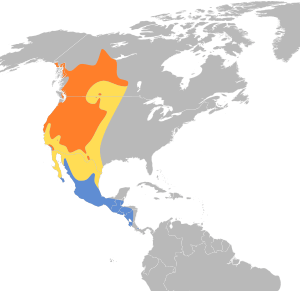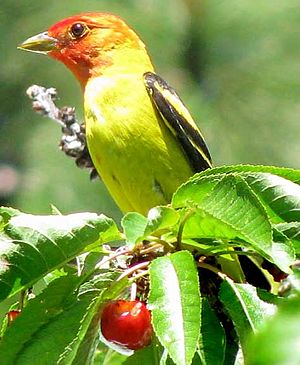Western tanager facts for kids
Quick facts for kids Western tanager |
|
|---|---|
 |
|
| A male Western Tanager in bright breeding colors | |
 |
|
| An adult female |
|
| Conservation status | |
| Scientific classification | |
| Genus: |
Piranga
|
| Species: |
ludoviciana
|
 |
|
| Where they live: Summer breeding range Winter non-breeding range Migration | |
The western tanager (Piranga ludoviciana) is a medium-sized American songbird. It used to be part of the tanager family (Thraupidae). Now, scientists place it and other birds in its group with the cardinal family (Cardinalidae). This bird's feathers and sounds are much like other birds in the cardinal family.
Contents
About the Western Tanager
How it was named
The Western Tanager was first drawn and described by an American bird expert named Alexander Wilson in 1811. He gave it the scientific name Tanagra ludoviciana. He studied a bird found during the Lewis and Clark Expedition (1803-1806). The name ludoviciana comes from an old Latin word meaning "Louis". This name refers to Louisiana, a large French area in the 1700s, not the state we know today.
Later, the Western Tanager was moved to the group of birds called Piranga. This group was named by a French bird expert, Louis Jean Pierre Vieillot, in 1808. There are no different types (subspecies) of the Western Tanager. It is just one kind of bird.
What it looks like
Western Tanagers are about 6.3 to 7.5 inches (16-19 cm) long. They weigh about 0.8 to 1.3 ounces (24-36 g). Their wings can spread about 11.5 inches (29 cm) wide.
Adult birds have pale, strong, pointed beaks. Their bellies are yellow, and their wings have light bars. Adult males are very colorful. They have a bright red face and a yellow neck, shoulders, and back. Their upper back, wings, and tail are black. When it's not breeding season, the male's head might only have a little red, and its body can look a bit olive green. Female Western Tanagers have a yellow head. Their backs are olive green, and their wings and tail are dark.
The Western Tanager's song sounds a bit like an American robin's song. But it is rougher and can be a bit boring. Their call sounds like pit-er-ick.
Where they live and travel
Western Tanagers live in coniferous (cone-bearing) or mixed forests. These forests are found across western North America. Their range goes from the Mexico-U.S. border up to southern Alaska. This means they are the tanagers that breed the farthest north.
These birds build a simple, cup-shaped nest. They usually place it on a flat tree branch, often in a conifer tree. Females lay four bluish-green eggs with brown spots.
Western Tanagers migrate (travel long distances). They spend their winters from central Mexico down to Costa Rica. Some also stay in Southern California during the winter.
Their homes
Western Tanagers breed in forests along the western coast of North America. This area stretches from southeastern Alaska down to northern Baja California, Mexico. They can also be found east to western Texas and north through New Mexico, Colorado, and parts of Nebraska and South Dakota. Their range goes up to the southern Northwest Territories in Canada.
In winter, Western Tanagers fly south. Their winter homes are from central Costa Rica north through Central America. They also winter in southern Baja California Sur and parts of Mexico. They usually do not live in the Caribbean lowlands. Sometimes, they are seen even farther south in Panama. Very rarely, they fly to the eastern United States.
Western Tanagers can live in different types of places. They are found in areas that have been changed by logging. They have also been seen in areas with saltcedar and Russian olive trees. In New Mexico, they were seen in tall saltcedar stands. Along the Rio Grande, they were often found in areas with cottonwood trees and Russian olive bushes.
Life and habits
Western Tanagers travel alone or in groups of up to 30 birds. Younger Western Tanagers usually start their fall migration later than adult birds.
Reproduction
Western Tanagers arrive at their breeding grounds in the spring. Most birds start breeding when they are two years old or older. This usually happens from May to July. Some younger birds might also breed. In New Mexico, males start singing in late May, and the first nests are found in early June.
The female builds the cup nest. It takes her about four or more days to build it. She uses twigs, small roots, grasses, and pine needles. Scientists have not found evidence that Western Tanagers have a second group of babies in one year. However, if a nest fails, they might try to nest again.
A female usually lays three to five eggs. In Colorado, the average was about 3.8 eggs per nest. It usually takes about one day to lay each egg. The female sits on the eggs for about 13 days to keep them warm. Both parents feed the young birds. The young birds usually leave the nest (fledge) 11 to 15 days after hatching. Young Western Tanagers have been seen with their parents for at least two weeks after leaving the nest.
Young Western Tanagers start their migration later than adult birds. Birds in northern areas leave in late summer or early fall. Birds in southern areas might stay until early November.
How many young birds survive varies a lot. Nest success can be as low as 3.5% or as high as 75.3%. The main reason nests fail is because predators eat the eggs or young birds.
Western Tanagers can live for several years. One wild Western Tanager was recorded living for 7 years and 11 months.
Where they nest
During the breeding season, Western Tanagers mostly live in open forests with conifer trees or mixed trees. During migration, they can be found in more places. These include lowland forests, desert oases, parks, and fruit farms. In their winter homes, they live in pine and pine-oak forests. They also live in low scrub forests, forest edges, and coffee farms.
Western Tanagers nest at many different heights. In the northern parts of their breeding range, they can be found from about 183 feet (56 m) up to over 8,300 feet (2,530 m). In the southern parts, they are more common at high places, like 8,270 feet (2,520 m) in Arizona.
Western Tanagers build nests in older conifer and mixed forests. They prefer areas with medium to large trees and lots of tree cover (more than 70%). Most nests are found in conifer trees, like Douglas fir. They are usually on horizontal branches, more than 10 feet (3 m) high. Sometimes, they use deciduous trees like quaking aspen. Nests are often far out on the branch, away from the tree trunk.
Where they find food

Western Tanagers look for food in many different places. They can be found in areas with young plants, like grass and wildflowers, all the way to old forests with large trees. They often look for food high up in the forest canopy (the top layer of leaves and branches). For example, in California, they spent most of their foraging time above 35 feet (10 m).
They often perch on small branches, less than 1 inch (2.5 cm) thick. They prefer to find food on larger trees, usually those taller than 33 feet (10 m) and with trunks wider than 8 inches (20 cm).
Western Tanagers might prefer certain types of trees for foraging. In California, they used white fir trees more often than expected. They used incense-cedar trees less. In British Columbia, they mostly foraged in Douglas fir trees.
Western Tanagers seem to prefer areas with a good mix of different tree sizes and types. They like large trees and a moderate amount of tree cover (40% to 69%). They tend to avoid areas where the tree cover is continuous. They are often found in older forests rather than very young ones.
What they eat
Western Tanagers get their food in two main ways:
- Foliage gleaning: They pick insects off leaves and branches.
- Hawking: They fly out from a perch to catch insects in the air.
The way they find food can change depending on where they are. In California, they did a lot of both gleaning and hawking. But in British Columbia, they mostly gleaned from leaves.
Western Tanagers eat mostly insects (about 82%) and some fruits (about 18%). They eat many kinds of insects. These include spruce budworms and tussock moth larvae. They also eat wasps, ants, beetles, and grasshoppers.
For fruits, they eat hawthorn apples, raspberries, mulberries, elderberries, serviceberries, and wild or cultivated cherries. They have also been seen drinking nectar from agave and eucalyptus plants. Sometimes, they eat Russian olive fruits or food left by humans, like bird seed.
Who preys on them
Several birds hunt Western Tanagers. These include red-tailed hawks, prairie falcons, northern goshawks, Mexican spotted owls, sharp-shinned hawks, and Cooper's hawks. Jays and other types of hawks are also major predators. Domestic cats also hunt Western Tanagers.
Many animals prey on Western Tanager nests. These include Clark's nutcrackers, northern pygmy owls, great horned owls, and jays (like scrub jays, pinyon jays, and Steller's jays). Other nest predators are black bears, prairie rattlesnakes, and bullsnakes.
Western Tanager nests can also be "parasitized" by brown-headed cowbirds. This means cowbirds lay their eggs in the tanager's nest. The tanager parents then raise the cowbird chicks, which can greatly reduce how many tanager chicks survive.
Images for kids
See also
 In Spanish: Tangara aliblanca migratoria para niños
In Spanish: Tangara aliblanca migratoria para niños




